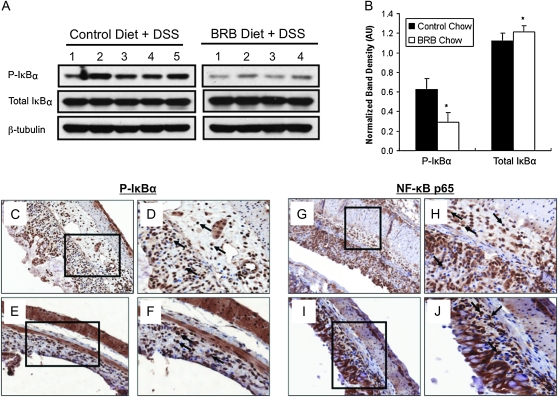Fig. 5.
The effects of BRB on DSS-induced changes in IκBα phosphorylation. Mice were administered 3% DSS in the drinking water concomitantly with either control or 10% BRB-incorporated powder diet. After 7 days, colons were harvested and protein lysates prepared for (A) immunoblotting analysis of P-IκBα and total IκBα protein expression. Numbers over lanes represent individual mice within treatment groups. (B) Band intensities were quantified as described in Materials and Methods. (C) Representative immunohistochemical staining for P-IκBα in a colonic section from a DSS-exposed mouse given control diet (×10). (D) Magnification of panel (C) (box), arrows indicate positively stained cells (×20). (E) Representative immunohistochemical staining for P-IκBα in a colonic section from a DSS-exposed mouse given BRB-incorporated diet (×10). (F) Magnification of panel (E) (box), arrows indicate positively stained cells (×20). (G) Representative immunohistochemical staining for NF-κB p65 in a colonic section from a DSS-exposed mouse given control diet (×10). (H) Magnification of panel (G) (box), arrows indicate positively stained cells (×20). (I) Representative immunohistochemical staining for NF-κB p65 in a colonic section from a DSS-exposed mouse given BRB-incorporated diet (×10). (J) Magnification of panel (I) (box), arrows indicate positively stained cells (×20). Images of entire slides containing immunohistochemically stained colon tissue sections we captured using ImageScope software (Aperio, Vista, CA). The magnifications listed for all representative images of stained sections are those designated by the software. Data are means ± standard errors of the mean, n = 5 mice per group. *P < 0.05, comparing control diet group and BRB diet group (unpaired t-test).

